Purulia, the westernmost district of West Bengal, is known as one of the state’s most under-developed regions. But very few would know about the history of socio-cultural revolt in Purulia. We can find various references to this land in different ancient Indian pieces of literature as Bajrabhumi, Shumbho Bhumi, Shikhar Bhum, Radha, Manbhum etc. Among all these references, Manbhum can be regarded as the most popular one as we still find people referring to it as 'Manbhum'. However, what rarely finds mention is the incredible natural beauty, ancient tribal folk culture and historical importance of the place.
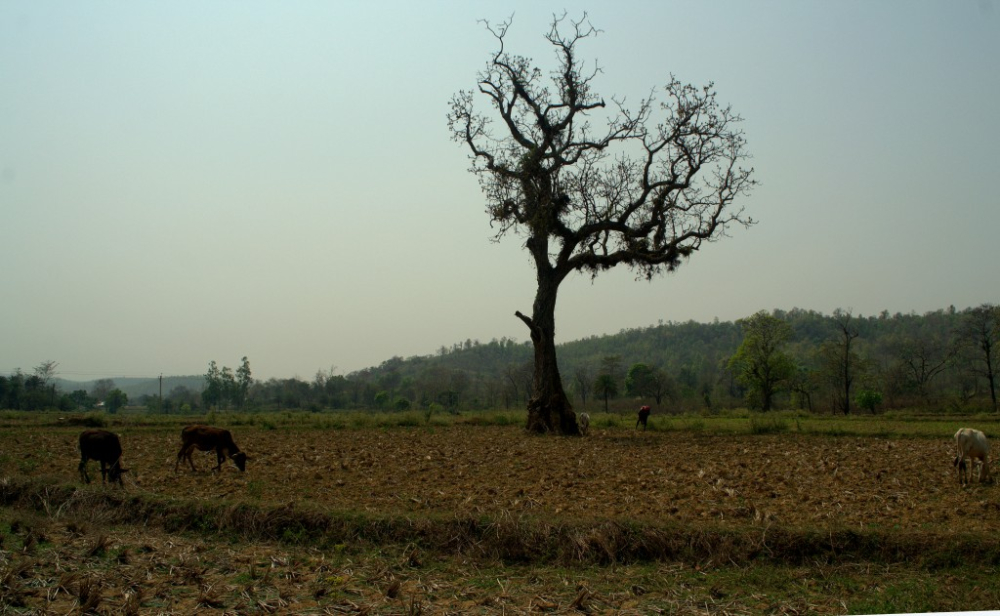
Fig 1: Purulia Landscape
As per the Census of 2011, this land is home to over 29 lakh people, and almost one-third of the district’s total population belongs to the Scheduled Caste and Scheduled Tribe categories, most of which are Santhals, the largest tribal community in India.
Tribal communities, including the Santhalis, have many festivals which are deeply related to nature and agriculture. Laying aside the burden of their poverty and day-to-day misery, the Santhali community of Purulia too comes together for such festivals, which increases their bond with nature as well.
'Saharay' is considered to be the biggest festival of the Santhali tribe. Though they have a lot of other festivals as well, they refer to this as the 'Hati Lekan Saharay', i.e., a festival as grand as the jungle elephant. Traditionally, it starts after the first day of amavasya (new moon) in the month of Karthik, and goes on for five days. Generally this festival is celebrated in the tribal villages and households at the beginning of the winter harvest. But it does not start on the same day in every village. It depends on the completion of harvesting and the financial condition of the villagers of that particular village. Villagers decide the day of initiation after having a meeting together, after which the manjhi (the head of the village) makes the declaration.

Fig 2: Meeting for declaration of the festival
Many Santhali scholars assume that the meaning of' Saharay is 'contractual surrender'. This assumption is linked to a story of the initiation of the Hindu festival of Diwali or Deepavali. According to this legend, the name came about after the Santhali’s victory over the outsiders in battle. After a long war, the outsiders surrendered to the Santhalis, who were helped by the goddess Kali Bonga. Before the contract was made, both sides communicated through messengers and decided to choose the time by lighting up diyas or clay lamps and they did that on the night of the amavasya (new moon). The lighting of each diya indicated their consent to a particular section of the contract. Thus, according to this myth, this was the initiation of the festival of Diwali (Reska 1894:46).
We find references to this legend in some of the Saharay songs such as the following:
Aar disham simare
Ehap ena tuput tapam
Hayre chandogating tignad rafa ruoyourem.
Boyes igna aauri chala
Mina gitign rilamala
Hayre chando gatign tignda rafa ruoyourem.
Translation
There is a war at the end of our land
I pray to you, oh almighty, may he return unharmed to me.
I am still young,
And in my mind I am missing him terribly
I pray to you, oh almighty, may he return unharmed to me.
Santhali Geeti: 60
However, there is another explanation of the origins of the festival where Saharay is seen as a remembering or celebrating of those who have helped the villagers sustain themselves. Here 'sahar' is translated as 'growth' and 'aay' as earnings or income. Therefore significance is given to the tradition of worshiping bullocks, cows and their lands.
One of the traditions at this time involves the invitation of a married woman along with her husband and children by her father or brother to her ancestral home. It is considered a very significant part of this festival which increases the quotient of the tribe’s happiness and prosperity.
Each day of the Saharay festival has its own significance and is known by different names. These are:
- Uhm Maha (Day 1)
- Saardi Maha (Day 2)
- Khuntao Maha (Day 3)
- Jaale Maha (Day 4)
- Gadoy Maha (Day 5)
Day 1: Uhm Maha
The first day of the Saharay festival is known as 'Uhm'. On this day, all the villagers, after taking an early bath, gather at the site of worship in an open place. This place is known as 'Ghnor' or 'Ghnod'. They are required to remain fasting on this day until the puja or ritual is complete.
As preparation, the Godet (assistant of the Naike or village priest) collects some amount of rice and a hen from every household and selects three hens from those to offer to their deity. This collected material is called 'Churuch Chaowle'. After his morning bath, the Naike draws small squares at the place of worship and spreads some rice on these while also drawing vermilion marks on them. They then offer the sacrifice of these hens to their deities Jaher-Era, Marangburu, Moreko-Turuiko, Gosai-Era Pargana Bonga and others and pray to save all the villagers from any danger. After the puja, they prepare khichdi (a meal made of rice and dal) along with the meat of the hens, which all the men of the village eat together. It is to be noted that women do not participate in this event and meal.

Fig 3: The Naike is preparing for the puja
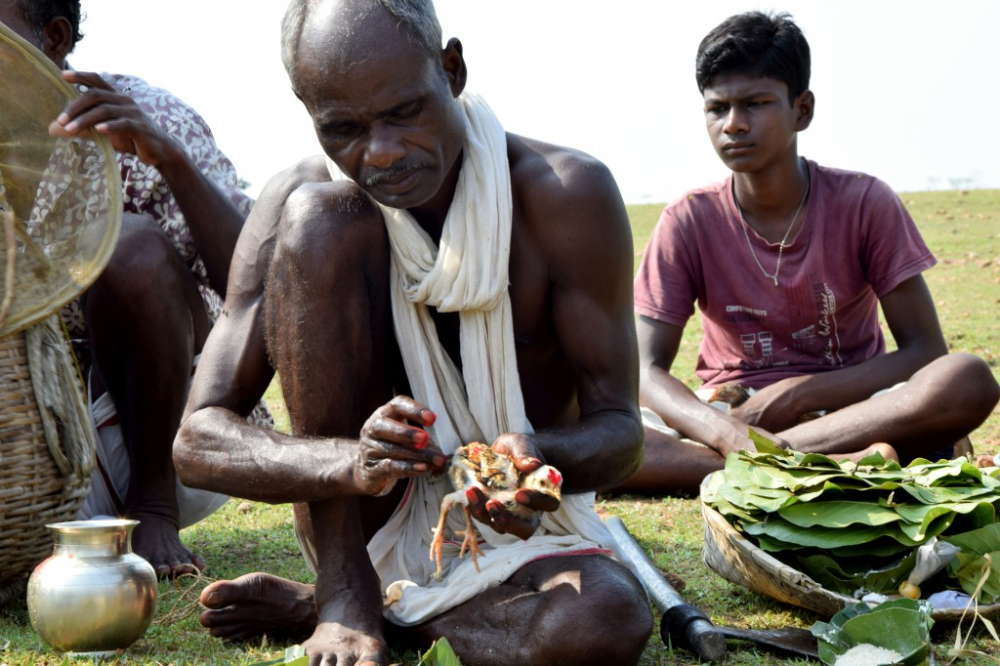
Fig 4: The Naike is preparing the hen before sacrificing it to their deities
Interestingly, along with their conventional deities, they also worship 'Sima Sare Bonga' or the 'apadevata' to appease his anger and calm him down. They choose one red-coloured cock for this and sacrifice it.
Another interesting ritual on the first day of Saharay involves the villagers putting an egg or some paddy stalk near the place of puja and then gathering all their cows to make them pass through this place. The cow which crushes the egg or passes over the paddy stalk is considered the 'holy cow' as it is believed that the blessings of the deities will rain upon them through that creature. The owner of the cow also gets special treatment in the village and has to distribute a can or jar full of handia (local beer made of rice) to the villagers.

Fig 5: Selecting the 'lucky cow'
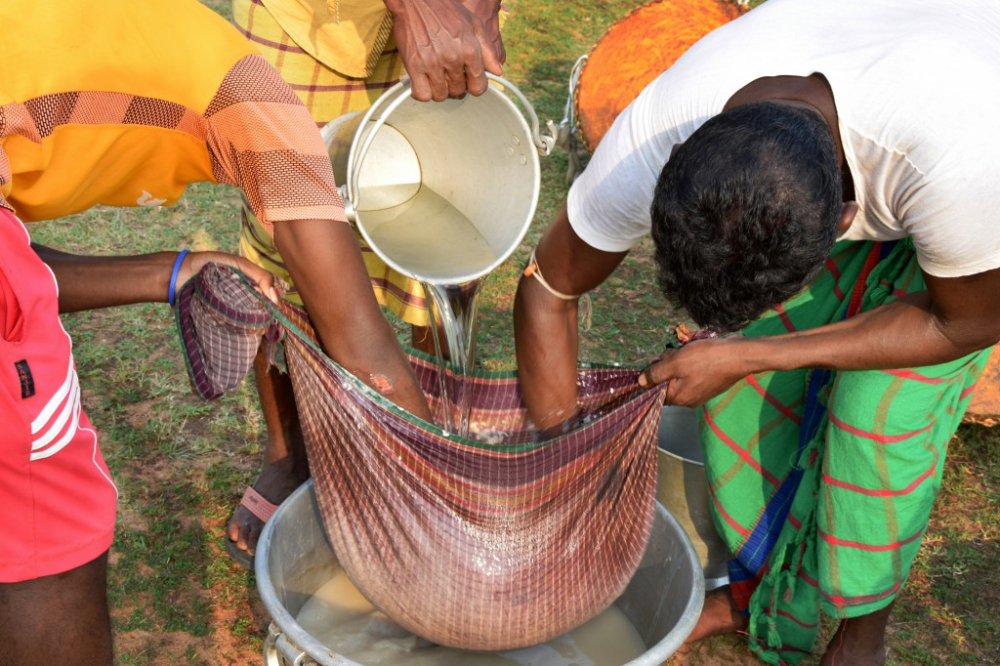

Fig 6: Enjoying the 'handia'
In the evening, after returning from the place of worship, they sing Jagarani Gaan (songs of awakening) for the well-being of the domestic animals. They do not even let their cows sleep for the whole night on this particular day.
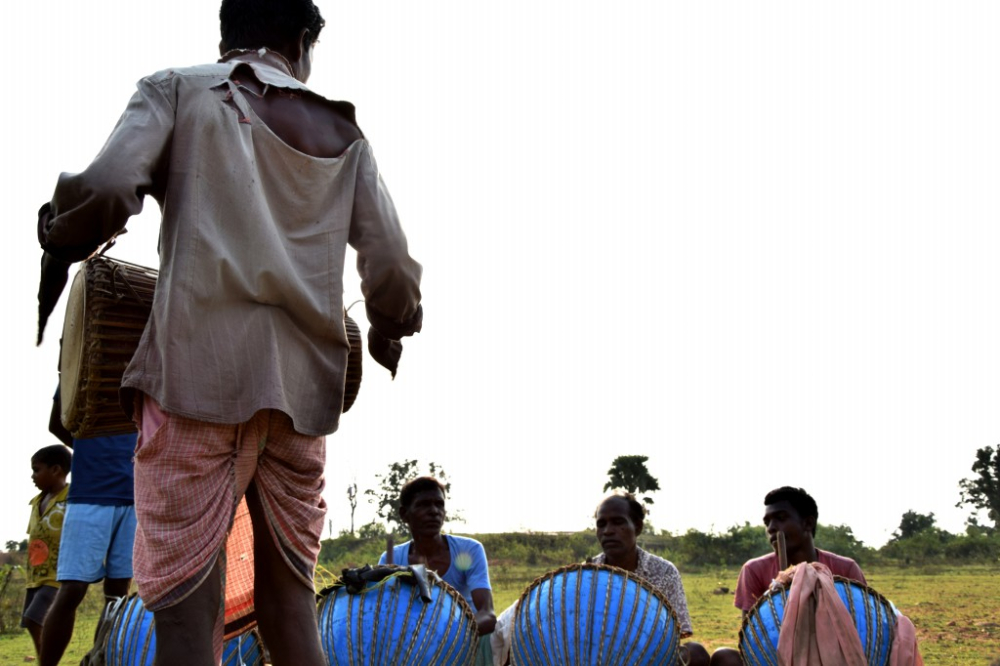
Fig 7: Music is an integral part of the festival
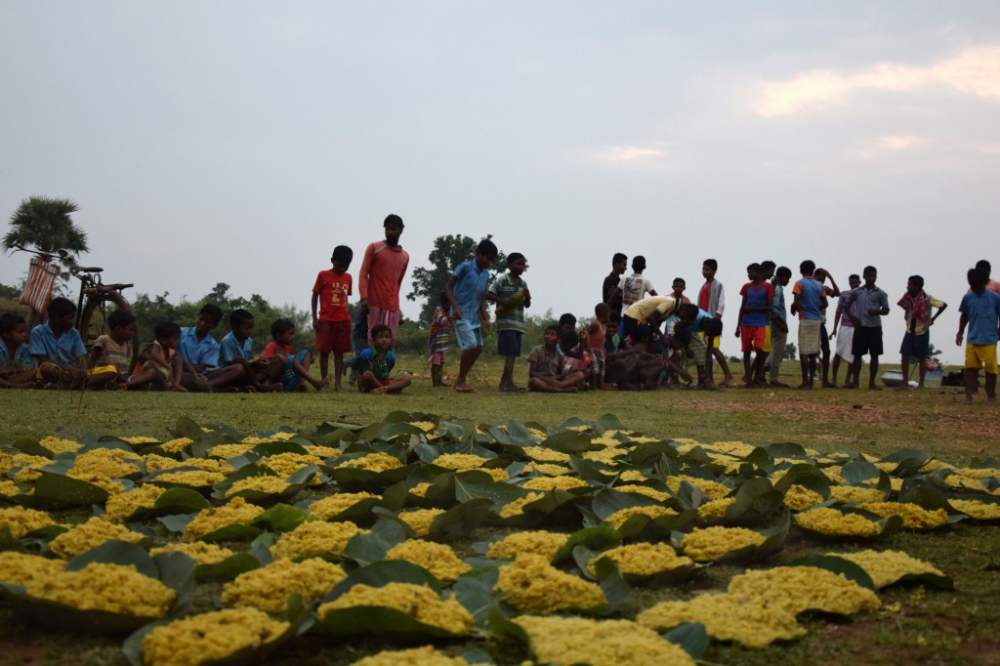
Fig 8: Having the day's meal together
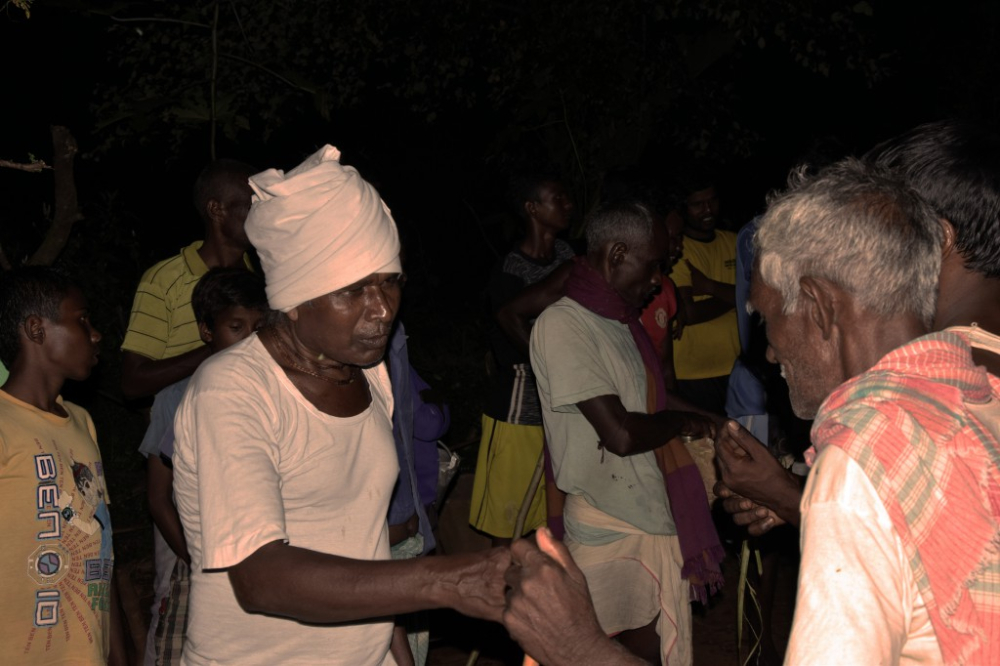
Fig 9: Singing Jagarani songs
Day 2: Saardi Maha
On this day, every Santhali worships Marangburu, their Griho-Devta or Kula-Devta (household deity) and their ancestors in their houses. This is also a time to reunite with their relatives and everyone sings, dances and drinks together.

Fig 10: Relatives from other villages come to celebrate the festival together
All the invited relatives gather on this day. The chief of the family invites his married daughter or sister to come to her parental house along with her husband and children. The Saharay songs wonderfully depict this situation when the woman comes to her parental house after a year.
Dada dada marang dada
Adiserma bad dadam neota kiding
Towa dare doya kaye na re
Alu maiyem rag ase
Alu maiyen hamra
Towadare Telkupi Barani Ghate sen akana
Translation
O brother, elder brother,
Oh, after how many days you have brought me home.
But where is our mother? Why cannot I see her, my mother, the tree of milk?
That tree of milk, our mother, has sailed away, sister,
Don’t cry, please don’t cry, oh dear sister.
The following verse expresses the anguish experienced by the woman if her family forgets to invite her, as well as her eagerness to reach to her ancestral house after getting the invitation.
Baru baruparam khan gelbar baru param khan
Marang daday neota akading
Mit kuti jil lagit mit chuput daka lagit
Marang daday neota akading
Translation
My elder brother has crossed several hills to invite me to his house.
Oh, my elder brother has crossed twelve hills, to invite me.
He has invited me to have some rice and a piece of meat at his house
***
Sagin disham baba aurah
Bir buru param re;
De juri taram taram me.
Hem rema babu menay
Bahar rema :haari
Bowu taram taram kaiya
Henod juri re
Translation
Oh my parental house is so far, after those hills, after those high lands
Come on, let’s be fast!
Can’t you see I am carrying our son on my shoulder and a jar of liquor on my head?
How can I walk fast like this?
Saothali Geeti: 58
They prepare a unique item of 'meat-cake' in the night and have that together with handia. Then they enjoy themselves singing and dancing till late into the night and sometimes till dawn. But sadly, this tradition of singing and dancing till dawn is now dying out. That is why, it is considered that the importance of Saharay needs to be emphasized more in Santhali society.
It is also on the second day, that the Santhalis clean all their agricultural tools and machinery as well as their cattle and then anoint the horns of their cattle with vermilion and oil.
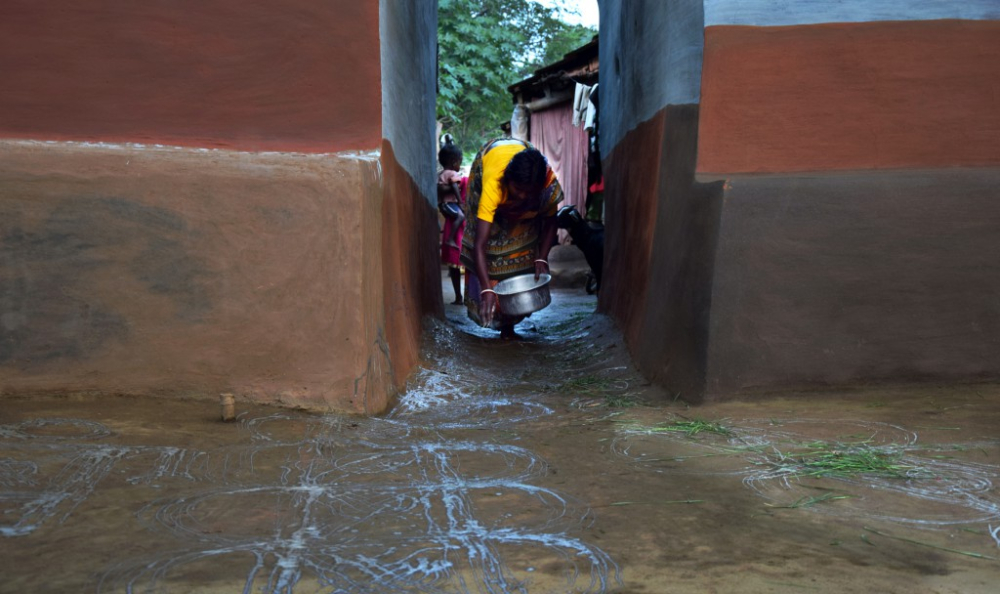
Fig 11: Decorating homes
They then worship their ancestors and 'Bonga Buru.' The women dress in simple clothes until the worship is done. They purify the place of worship with cow dung. The ingredients for the puja are very basic. They offer chicken, rice, paddy stalks and handia to the 'Bonga Buru'. They prepare three small heaps of rice and spread vermilion on that and put a pitha (cake made of rice) on top of every heap. They then pour the blood of the sacrificed chicken on the heap and consider this as their offering to the ancestors and spirits. After this they prepare a unique item with the rice and heads of the chicken which is known as 'Sorey'. It is prepared to offer to their Gods (Bongas) only. A separate meal is prepared for the family members with the rest of the chickens and from that a special share is allocated to the head of the family. Generally, Santhali families celebrate this day in their own houses.
Day 3 : Khuntao Maha
The third day of the festival is known as 'Khuntao Maha' or popularly as 'Goru Khunta'. In the morning all the villagers seek official permission from the head of their village to initiate the day’s event. 'Goru Khunta' is actually teasing the cows and 'Kara Khunta' is actually teasing the bullocks which are used in the field for harvesting. This whole process works as an exercise for these cattle before the winter harvesting season as all these cows or bullocks become somewhat idle after the rain-crop season.

Fig 12: Villagers preparing for 'Goru Khunta'
They anoint the horns of their domestic animals with vermillion, oil and paddy stalks. Women spread rice, soft grass and atap rice (a special kind of rice) on the cows as well as in the cowshed. Then those cows are taken to a vacant place beside their houses or in a field to celebrate 'Goru Khunta'. On this day, the husband of the daughter or sister is gifted a new cloth (dhoti) and is requested to dig the hole and put in the wooden pillar to which the bullock is tethered.
In the afternoon, the men of the village tie each bullock to a post and start to tease them with beats of dhamsa and madol (different kind of drums) along with the flute. A piece of dry leather of cow or bullock is waved in front of the creature, which riles it up to chase and hit the players. This is repeated three times for each bullock until it gets exhausted. They sing particular songs in this event which are known as 'Ohire' songs. 'Ohire' songs are actually hymns dedicated to the cows or bullocks. After this the cattle are returned to their sheds and the men and women begin to rejoice with singing and dancing. The women adorn themselves wonderfully and sing and dance their traditional forms accompanied by the men with dhamsa, madol and flute. The invited guests, relatives and even the elderly people of the village participate in the festivities which continue throughout the night.

Fig 13: The chase
In some villages, there is also a tradition of presenting different individual performances by the men of the village and the relatives who have been invited.

Fig 14: Villagers are getting ready to show their skills with sticks
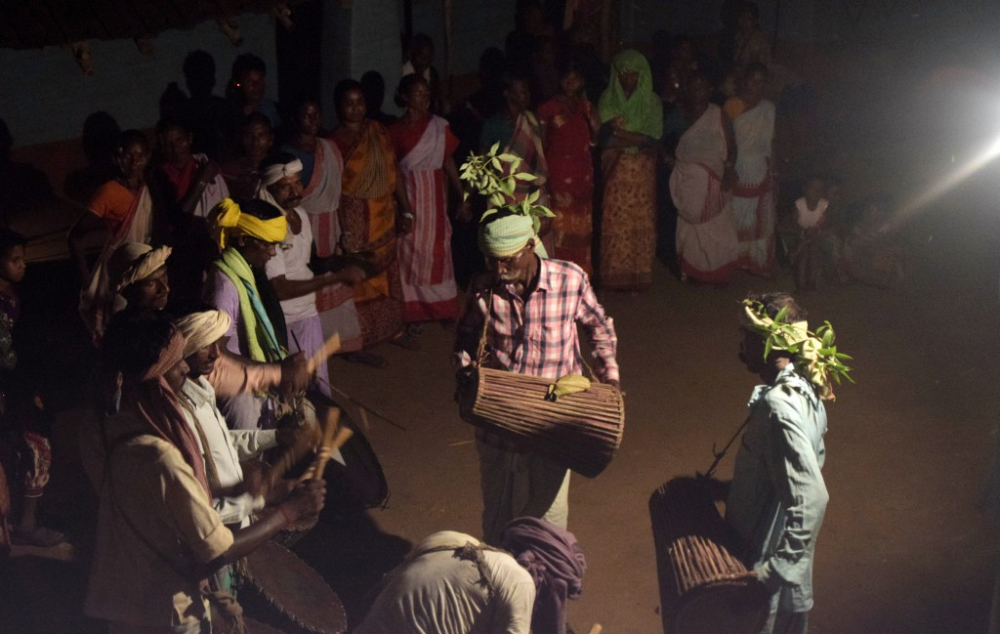
Fig 15: The night-long celebration
Day 4 : Jaale Maha
The fourth day of the festival is known as 'Jaale Maha'. On this day, the young men of the village go from home to home singing and dancing and collect handia along with other materials like salt, rice, etc. In the past, they would deliver all these materials to Jug Majhi’s home and later enjoy a feast. But this tradition is rarely seen in present times.
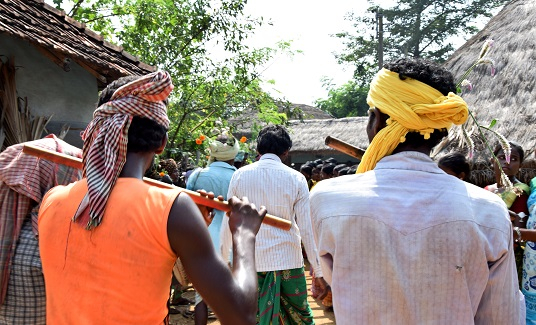
Fig 16: Collecting handia on Jaale Maha
Day 5 : Gaadoy Maha
'Gaadoy Maha', the fifth day of the festival bears significant importance. As per the traditions of Santhali society, the young and unmarried folk get to enjoy singing and dancing together. But the 'Jug Majhi' keeps observing that they do not get involved in any unpleasant incident which is against the norms of their society. The 'Jug Majhi' is selected from the five headmen of the village. When the five-day long festival reaches its final day, the 'Jug Majhi' hands over the young folk to their families and announces the official conclusion of the festival.

Fig 17: The 'Jug Majhi' is returning back a girl to her parents at the end of the festival
This is the way to declare them as being cleansed and that the liberties they enjoyed during the festival will now be withdrawn. Thus, the festival comes to an end by returning them back to the regular society.
Importance of the Festival
It will be unfair and a half-truth to describe Saharay as only being a harvest festival and the biggest one for the Santhalis. Its significance is actually far greater than that. For it is this very festival that indicates how rooted this tribe is in nature and how its heritage flows from one generation to another. This tribe does not worship any idol or statue, but only nature. They are well aware that not only their tribe but the whole human race will be extinct if the destruction of nature continues like this. So they prefer to stay in the midst of nature and pray and worship to the natural forces wholeheartedly but without any exorbitance. They believe that if the traditional values of this festival begin to die out and the younger generation starts to forget them, the whole human race will face the danger of extinction. Their prayers to the almighty are reflected in their songs full of immense emotional attachment and simplicity.
Ale bidoul re daw chando jhamar jhamar daagme
Ale bidoul dore chando saoyay ale me
Saoyay ape reh manwoa houdi ape pourouyape
Hor laha laha tepe kuchur baraya
Translation
Give us a field full of crops, oh almighty,
And pour heavy rain on us.
If I give you crops, you will make handia of it.
You will have to promise that you will not become drunk
And engage in any unpleasant incident.
Santhali Geeti: 59
When in this present world we are constantly losing touch and contact with one another, this festival keeps a sense of oneness alive among the tribe. It is unheard of for any Santhali family to not invite their married daughter or sister along with her husband or children by this time. This 'togetherness' is the essence of this festival as well the tribe; they sing together, they dance together and the concept of the nuclear family is still out of their distant imagination.
The significance of the festival extends from agriculture to household maintenance. The Santhali villagers live in mud houses and the rainy season causes damage to their houses every year. So to repair the damages and make their houses attractive once again, the Santhali women fix the walls and floors of their houses and paint them wonderfully with traditional arts. It is really astonishing that they do not have any formal training of arts and crafts but the raw beauty of these arts cannot be expressed in words.

Fig 18: Wall paintings during the festival

Fig 19: Wall paintings during the festival
It is to be noted that, these paintings are done by the women of the village only and they use only natural colours for this purpose. Another reason of painting the walls after repairing them is to protect the walls from wear and tear till the next monsoon. This is the tradition they have learnt and practised since the ancient times when television and 'wall paint' commercials were distant dreams.
All the varieties of songs sung by them during this festival bear the values and traditions of this tribe. All the love, affection, care, grief and happiness of these nature-loving people is reflected in these songs. A variety of dance forms are practiced at this time as well like 'Dang', 'Lagre', 'Ringza Matwar', etc.
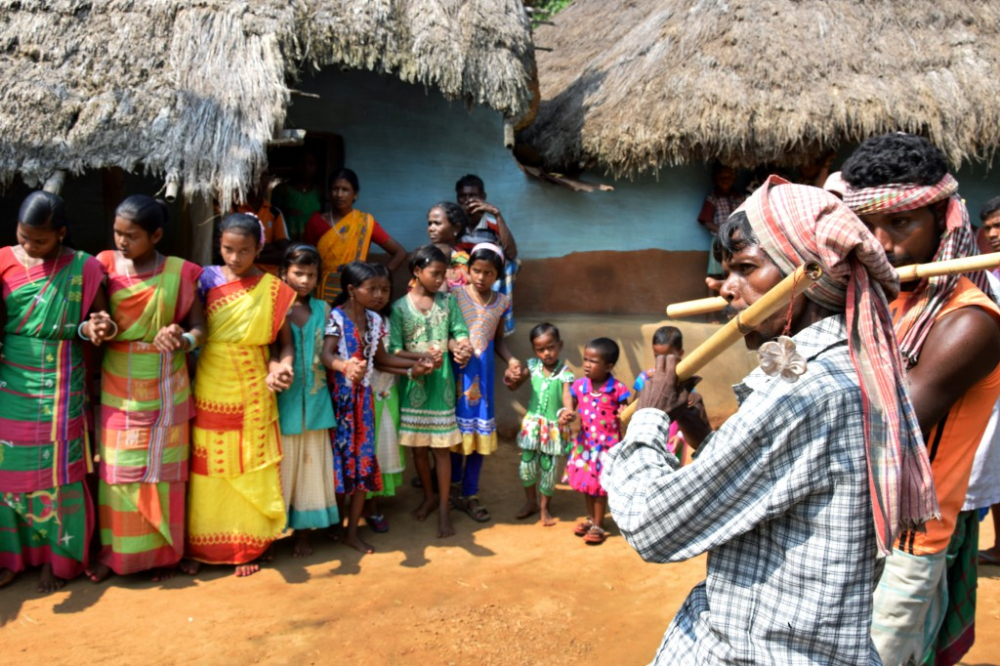
Fig 20: A variety of dance forms are performed during Saharay

Fig 21: The songs celebrate the Santhals' bond with nature
But it is a real matter of concern that the aggression of modern society is destroying this culture slowly but constantly. Should this happens, it will be a great loss for the culture and the ethnic values of this country as well. If we fail to restore and refurbish this cultural heritage, then we will have to keep repenting like Tagore once wrote, 'Bring back those forests, take away this city.'
References and Further Reading
Acharya, Nandadulal, trans. n.d. Saotali Geeti (Santhali Songs, Bengali Translation)
Baskey, Dhirendranath. 1981. Poschimbonger Adibasi Samaj (Tribal Communities of West Bengal), Part 1.
Reska, Ramdas Tudu. 1894. Kherwal Bongsha Dharam Punthi (Ancestral Book of Santhali Religion and Culture), translated into Bangla by Sukumar Sikdar & Sarada Prasad Kisku.

